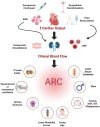Pharmacotherapy variability and precision medicine in neurocritical care
- PMID: 40757024
- PMCID: PMC12314178
- DOI: 10.3389/fneur.2025.1630163
Pharmacotherapy variability and precision medicine in neurocritical care
Abstract
Pharmacotherapy variability is defined as the variability in drug response among and within individuals that is attributed to the inter and intra-individual differences in the action and disposition of drugs. Neurological and medical complications in neurocritical care contribute significantly to the overall disease prognosis. Pharmacological management plays a key role in managing many of those complications such as cerebral vasospasm, delayed cerebral ischemia, hyponatremia, infections, and seizures. However, pathophysiologic changes secondary to neurological and critical illnesses make the medical management of these patients challenging, contributing to pharmacotherapy variability. Interindividual differences in disease pathophysiology, altered organ function, systemic inflammation, hemodynamic instability, and common interventions employed in intensive care settings could alter the pharmacokinetics and pharmacodynamics of medications. The use of potentially ineffective treatments and suboptimal dosing of medications to manage patients can lead to poor outcomes as the understanding of the effect of neurological injury on the action and disposition of drugs is limited. This narrative review highlights the factors contributing to pharmacotherapy variability in neurocritical care, equipping clinicians with critical insights to refine patient management strategies. In conclusion, pharmacotherapy variability within neurocritical care introduces additional layers of complexity that may significantly contribute to therapy failure, adverse drug reactions, and setbacks in drug development. Understanding these variations is essential for identifying subpopulations that may derive the greatest benefit from specific therapies, representing a critical step toward achieving precision medicine in neurocritical care, ensuring the administration of the appropriate medication to the right patient at the correct dosage regimen.
Keywords: neurocritical care; pharmacodynamics; pharmacokinetics; pharmacotherapy; precision medicine.
Copyright © 2025 Mahmoud, Kharouba, Aboelezz, Elshamy and Gunn.
Conflict of interest statement
The authors declare that the research was conducted in the absence of any commercial or financial relationships that could be construed as a potential conflict of interest.
Figures




Similar articles
-
Management of urinary stones by experts in stone disease (ESD 2025).Arch Ital Urol Androl. 2025 Jun 30;97(2):14085. doi: 10.4081/aiua.2025.14085. Epub 2025 Jun 30. Arch Ital Urol Androl. 2025. PMID: 40583613 Review.
-
[Guidelines for the prevention and management of bronchial asthma (2024 edition)].Zhonghua Jie He He Hu Xi Za Zhi. 2025 Mar 12;48(3):208-248. doi: 10.3760/cma.j.cn112147-20241013-00601. Zhonghua Jie He He Hu Xi Za Zhi. 2025. PMID: 40050074 Chinese.
-
The Black Book of Psychotropic Dosing and Monitoring.Psychopharmacol Bull. 2024 Jul 8;54(3):8-59. Psychopharmacol Bull. 2024. PMID: 38993656 Free PMC article. Review.
-
Multidisciplinary collaborative guidance on the assessment and treatment of patients with Long COVID: A compendium statement.PM R. 2025 Jun;17(6):684-708. doi: 10.1002/pmrj.13397. Epub 2025 Apr 22. PM R. 2025. PMID: 40261198
-
Sexual Harassment and Prevention Training.2024 Mar 29. In: StatPearls [Internet]. Treasure Island (FL): StatPearls Publishing; 2025 Jan–. 2024 Mar 29. In: StatPearls [Internet]. Treasure Island (FL): StatPearls Publishing; 2025 Jan–. PMID: 36508513 Free Books & Documents.
References
Publication types
LinkOut - more resources
Full Text Sources

